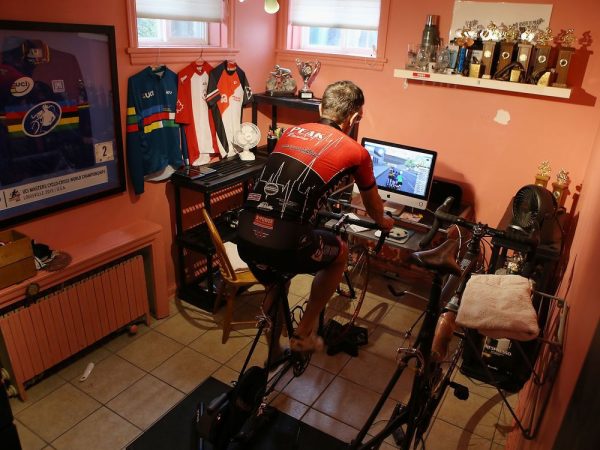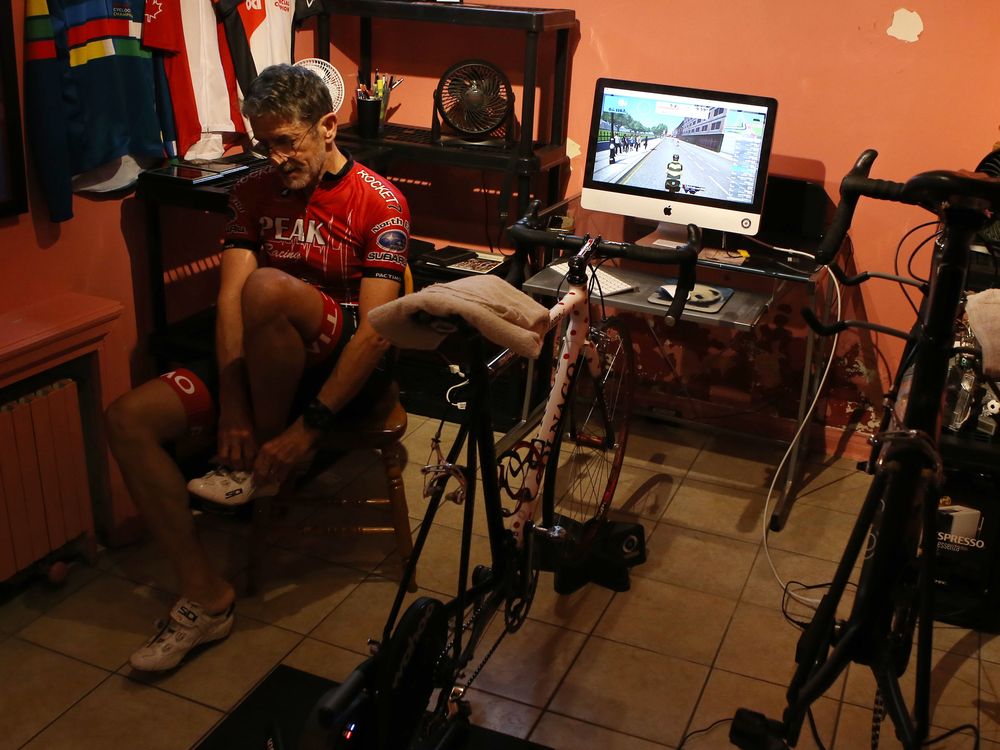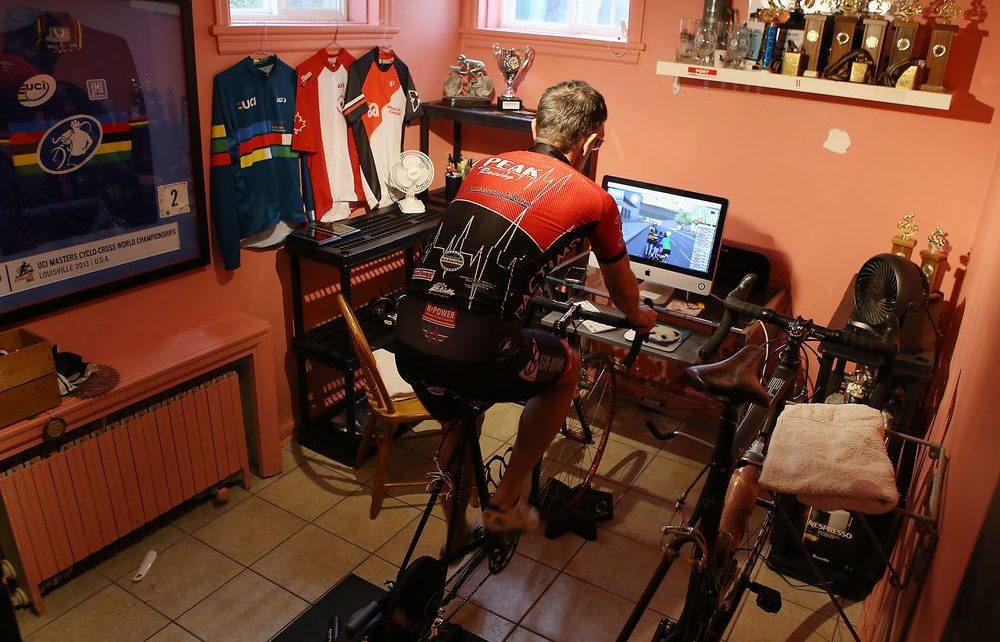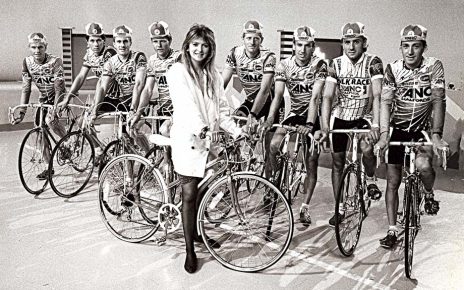
Cyclist Jim Laird goes for a virtual bike ride in the basement of his house in Kingston on Monday. (Elliot Ferguson/The Whig-Standard) Elliot Ferguson / Elliot Ferguson/Whig-Standard
KINGSTON — Illuminated by a small set of track lights on the ceiling, cyclist Jim Laird climbed on his bike Monday morning for a casual ride around London, England.
The walls and shelves of the dimly lit, salmon-coloured room are lined with medals and trophies won in bike races over the years, including champion jerseys from provincial, national, Pan-American and world championships.
It’s a collection Laird, and everyone else, won’t be adding to anytime soon.
Like sports everywhere, the cycling season has been a victim of the pandemic, with racing calendars — amateur and professional alike — halted midway or cancelled before they even began.
While many sports have come to a complete stop, robbed of the rinks, fields and pitches needed to compete, an online option has allowed some cyclists to keep rolling.
Using computerized smart trainers wirelessly connected to the internet that take the place of their bike’s rear wheel, cyclists can monitor their speed, cadence and power output that, in turn, are used to gauge their performance against other cyclists using the program.
The American program Zwift has become a popular off-season training tool and, while virtual cycling eliminates many of the variables that are a big part of cycling, such as road or trail conditions, other people and the weather, the subscription program has offered a place for racers to get their competitive fix.
“Riding virtually you still have someone up the road and somebody trying to chase you down,” Laird said. “Racing, simplified, is you catch the guy in front of you and you stay ahead of the guy behind you. If you are lucky, you will be the first one across the line.
“The simulation of a virtual race is very competitive, and if you are a competitive rider, you will get your kicks.”
Laird likened virtual racing to CrossFit when it began as a training regimen for athletes before becoming a sport itself, with its own competitions and championships.
The racing programs have monthly subscription fees and the cheapest wireless smart trainer costs from about $350 up to almost $2,000, but those amounts are less than some competitive cyclists would spend per year on race entry fees, travel and accommodation expenses.
Indoor virtual racing could take on a life of its own if more people get used to it, Laird said.
“We’ve all had our crashes in live racing, myself included. Broken bones, concussions. That is taken away so you can concentrate on your power numbers, your cadence,” he said. “When you are outside, you are dealing with all the other bikes around you, the road conditions, the weather, the wind. Those things are missing from the online, but it is damn close.”
On Saturday, the Ontario Cycling Association staged the first in a series of weekly virtual road races that it is hosting as an alternative to the summer race series that were all cancelled because of the pandemic.
Cyclists in a road race often ride within a few centimetres of each other, and the 62-kilometre virtual race attracted 260 competitors who were able to compete while still maintaining social distance.
“With the future of outdoor cycling events and races in Ontario currently uncertain due to the COVID-19 situation and physical distancing practices, the Ontario Cycling Association recognizes the need for the cycling community to come together during these difficult times,” the OCA’s Chantal Thompson, who organized the series, said.
“Our hope is that by creating an organized weekly virtual race, we can provide a relatively accessible cycling experience for our membership which will encourage maintenance of fitness as well as social ties.”
Virtual racing is an outlet when there are few other options for bike racing, Kingston cyclist Dave Wall said, but it doesn’t yet replace the real thing.
“It’s still a race and it’s still a good effort,” Wall, who competed in Saturday’s race and finished in the middle of the standings, said. “You still have to go with a really strong effort. You can’t coast along.
“It’s a substitute for the lack of racing we have right now.”
Wall said he left road racing after a particularly bad crash about 10 years ago. He now does most of his riding and racing on gravel roads, a type of cycling that has seen rapid growth in the past few years.
“It is what it is and, given the pandemic, we’re kind of limited in what we can and cannot do,” he said. “This gives you that opportunity to test your fitness level against other people.”
That said, it’s what virtual racing lacks that makes it less attractive than bike racing outside.
“There’s a lot more strategy that happens on the road. You get to see where things are going and you get to communicate a bit more,” he said.
”You can see the courses online a bit in the event — it will tell you there’s going to be elevation — but it’s a little different than being out on the road where you can see, ‘Oh, that’s a monster hill in front of me. I should get to the front of the group so by the time we get to the top I’m still hanging on to the back pack.’”
As the warm weather arrives, more people will go out on their bikes, and public health officials are encouraging people to get exercise for their mental and physical well-being so long as social distancing can be maintained.
But racing and even training for competition should be done inside to eliminate the possibility of crashing and adding to the burden on the health-care system, Laird said.
For more casual bike rides, Laird and Wall both said the K&P Trail gives them a place where they can ride without worrying about motor vehicles.
“I believe if you can, you should train indoors,” he said. “If I want to hit it hard, I’m not going to do that outdoors.”

Cyclist Jim Laird takes off his shoes after a virtual bike ride in the basement of his house in Kingston on Monday. (Elliot Ferguson/The Whig-Standard)
Elliot Ferguson / Elliot Ferguson/Whig-Standard



